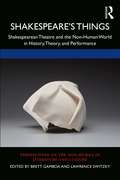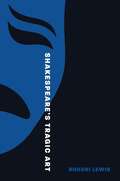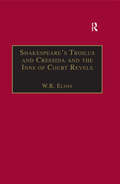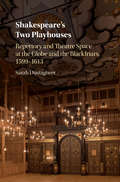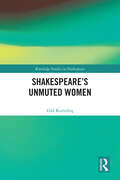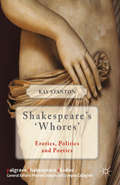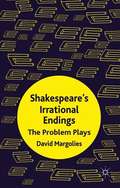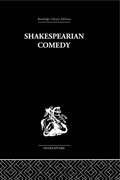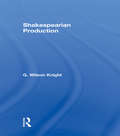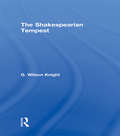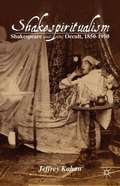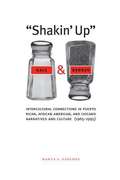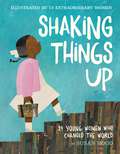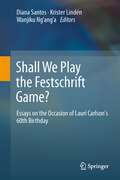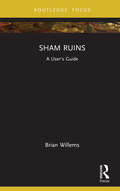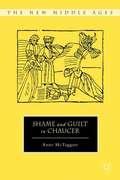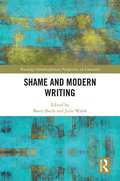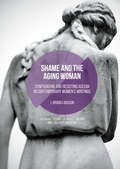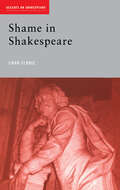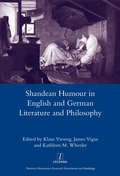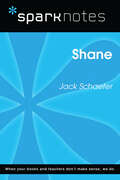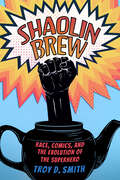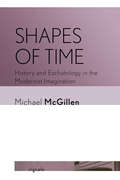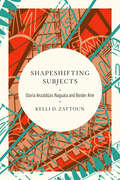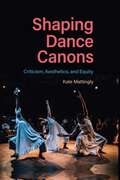- Table View
- List View
Shakespeare’s Things: Shakespearean Theatre and the Non-Human World in History, Theory, and Performance (Perspectives on the Non-Human in Literature and Culture)
by Brett Gamboa Lawrence SwitzkyFloating daggers, enchanted handkerchiefs, supernatural storms, and moving statues have tantalized Shakespeare’s readers and audiences for centuries. The essays in Shakespeare’s Things: Shakespearean Theatre and the Non-Human World in History, Theory, and Performance renew attention to non-human influence and agency in the plays, exploring how Shakespeare anticipates new materialist thought, thing theory, and object studies while presenting accounts of intention, action, and expression that we have not yet noticed or named. By focusing on the things that populate the plays—from commodities to props, corpses to relics—they find that canonical Shakespeare, inventor of the human, gives way to a lesser-known figure, a chronicler of the ceaseless collaboration among persons, language, the stage, the object world, audiences, the weather, the earth, and the heavens.
Shakespeare’s Tragic Art
by Rhodri LewisA new account of Shakespearean tragedy as a response to life in an uncertain worldIn Shakespeare&’s Tragic Art, Rhodri Lewis offers a powerfully original reassessment of tragedy as Shakespeare wrote it—of what drew him toward tragic drama, what makes his tragedies distinctive, and why they matter.After reconstructing tragic theory and practice as Shakespeare and his contemporaries knew them, Lewis considers in detail each of Shakespeare&’s tragedies from Titus Andronicus to Coriolanus. He argues that these plays are a series of experiments whose greatness lies in their author&’s nerve-straining determination to represent the experience of living in a world that eludes rational analysis. They explore not just our inability to know ourselves as we would like to, but the compensatory and generally unacknowledged fictions to which we bind ourselves in our hunger for meaning—from the political, philosophical, social, and religious to the racial, sexual, personal, and familial. Lewis&’s Shakespeare not only creates tragedies that exceed those written before them. Through his art, he also affirms and invigorates the kinds of knowing that are available to intelligent animals like us.A major reevaluation of Shakespeare&’s tragedies, Shakespeare&’s Tragic Art is essential reading for anyone interested in Shakespeare, tragedy, or the capacity of literature to help us navigate the perplexities of the human condition.
Shakespeare’s Troilus and Cressida and the Inns of Court Revels
by W.R. Elton’No one of Shakespeare’s plays is harder to characterize’, said Coleridge of Troilus and Cressida. Over the centuries, generations of critics have faced the challenge of determining exactly what sort of play Shakespeare’s Troilus and Cressida is. Described by Victorian commentators as ’dark’, ’decadent’ and ’bitter’, the work has, until now, retained its designation as a ’problem play’. In this ground-breaking study, leading Shakespeare scholar, W R Elton attempts to dismantle this presumption. His research places the play in the historical context of the Inns of Court law-revels tradition. By close analysis of the text, Elton demonstrates his belief that Troilus and Cressida was written specifically for an audience of law students and lawyers and that the play manifests many elements of a law-revel, including misrule, inversion, mock rhetoric and logic, and mock trials. In so doing, he provides explanations for many of the puzzling and mysterious elements that have previously baffled critics.
Shakespeare’s Two Playhouses: Repertory and Theatre Space at the Globe and the Blackfriars, 1599–1613
by Sarah DustagheerIn what ways did playwrights like Shakespeare respond to the two urban locations of the Globe and the Blackfriars? What was the effect of their different acoustic and visual experiences on actors and audiences? What did the labels 'public' for the Globe and 'private' for the Blackfriars, actually mean in practice? Sarah Dustagheer offers the first in-depth, comparative analysis of the performance conditions of the two sites. This engaging study examines how the social, urban, sensory and historical characteristics of these playhouses affected dramatists, audiences and actors. Each chapter provides new interpretations of seminal King's Men's works written as the company began to perform in both settings, including The Alchemist, The Tempest and Henry VIII. Presenting a rich and compelling account of the two early modern theatres, the book also suggests fresh insights into recent contemporary productions at Shakespeare's Globe, London and the new Sam Wanamaker Playhouse.
Shakespeare’s Unmuted Women (Routledge Studies in Shakespeare)
by Gül KurtuluşShakespeare’s Unmuted Women explores women’s speeches in selected plays by Shakespeare, highlighting women’s discerning insight as a vital ingredient in these selected works. The book discusses the use of rhetoric in speeches by women as a cementing material that supports the casing of the incidents. Women holding forth on the issues related to the common concerns emerged in the plays perform a distinguishing role in strengthening the bond between decisions taken and executed by each character and make their major important contribution to the overall impact of the play. Comprising six chapters, the volume analyses Cordelia’s and Desdemona’s speeches in King Lear and Othello; Cleopatra’s and Tamora’s speeches in Antony and Cleopatra and Titus Andronicus; Beatrice’s and Rosalind’s speeches in Much Ado About Nothing and As You Like It; and Katherine’s and Lady Anne’s speeches in Henry V and Richard III, respectively. The text discusses women’s rich and profound discourse in these works to accentuate the meaningful input in verbal communication. In Shakespeare’s selected plays, women’s insightfulness and perspicuity are closely considered to emphasize how women make efficient use of rhetoric, aptly used by Queen Elizabeth I during Shakespeare’s time. Queen Elizabeth’s outstanding public speeches inspired those who listened to her and Shakespeare’s women are partial embodiments of her.
Shakespeare’s ‘Whores’
by Kay StantonShakespeare's 'Whores' studies each use of the word 'whore' in Shakespeare's canon, focusing especially on the positive personal and social effects of female sexuality, as represented in several major female characters, from the goddess Venus, to the queen Cleopatra, to the cross-dressing Rosalind, and many others.
Shakespeare�s Irrational Endings
by David MargoliesProblem Plays' has been an awkward category for those Shakespeare plays that don't fit the conventional groupings. Expanding from the traditional three plays to six, the book argues that they share dramatic structures designed intentionally by Shakespeare to disturb his audience by frustrating their expectations.
Shakespearian Comedy
by H. B. CharltonFirst published in 1938. This is a survey of Shakepeare's comedies which illustrates the playwright's increasing grasp on the art and idea of comedy. Themes, characters and plays covered include: Romanticism in Shakespearian comedy; Shakespeare's Jew, Falstaff, The Taming of the Shrew, A Midsummer Night's Dream, and The Dark Comedies.
Shakespearian Production V 6: With Especial Reference To The Tragedies
by G. Wilson KnightThis part of the G. Wilson Knight collected works, Volume VI looks at his view on Shakespearian production with special reference to the Tragedies.
Shakespearian Tempest - V 2
by G. Wilsin KnightFirst published in 2002. Routledge is an imprint of Taylor & Francis, an informa company.
Shakespiritualism
by Jeffrey KahanThis study concerns itself with a now-forgotten religious group, Spiritualists, and how their ensuing discussions of Shakespeare's meaning, his writing practices, his possible collaborations, and the supposed purity and/or corruption of his texts anticipated, accompanied, or silhouetted similar debates in Shakespeare Studies.
Shakin' Up Race and Gender: Intercultural Connections in Puerto Rican, African American, and Chicano Narratives and Culture (1965-1995)
by Marta Ester SánchezThe second phase of the civil rights movement (1965-1973) was a pivotal period in the development of ethnic groups in the United States. In the years since then, new generations have asked new questions to cast light on this watershed era. No longer is it productive to consider only the differences between ethnic groups; we must also study them in relation to one another and to U.S. mainstream society.<P><P>In "Shakin' Up" Race and Gender, Marta E. Sánchez creates an intercultural frame to study the historical and cultural connections among Puerto Ricans, African Americans, and Chicanos/as since the 1960s. Her frame opens up the black/white binary that dominated the 1960s and 1970s. It reveals the hidden yet real ties that connected ethnics of color and "white" ethnics in a shared intercultural history. By using key literary works published during this time, Sánchez reassesses and refutes the unflattering portrayals of ethnics by three leading intellectuals (Octavio Paz, Daniel Patrick Moynihan, and Oscar Lewis) who wrote about Chicanos, African Americans, and Puerto Ricans. She links their implicit misogyny to the trope of La Malinche from Chicano culture and shows how specific characteristics of this trope--enslavement, alleged betrayal, and cultural negotiation--are also present in African American and Puerto Rican cultures. Sánchez employs the trope to restore the agency denied to these groups. Intercultural contact--encounters between peoples of distinct ethnic groups--is the theme of this book.
Shaking Things Up: 14 Young Women Who Changed the World
by Susan Hood“Each poem and illustration shines with a personality all its own.” —Shelf Awareness (starred review)“This book has definitely made an impact on my life.” —Kitt Shapiro, daughter of Eartha KittFresh, accessible, and inspiring, Shaking Things Up introduces fourteen revolutionary young women—each paired with a noteworthy female artist—to the next generation of activists, trailblazers, and rabble-rousers.From the award-winning author of Ada’s Violin and Lifeboat 12, Susan Hood, this is a poetic and visual celebration of persistent women throughout history.In this book of poems, you will find Mary Anning, who was just thirteen when she unearthed a prehistoric fossil. You’ll meet Ruby Bridges, the brave six-year-old who helped end segregation in the South. And Maya Lin, who at twenty-one won a competition to create a war memorial, and then had to appear before Congress to defend her right to create.And those are just a few of the young women included in this book. Readers will also hear about Molly Williams, Annette Kellerman, Nellie Bly, Pura Belpré, Frida Kahlo, Jacqueline and Eileen Nearne, Frances Moore Lappé, Mae Jemison, Angela Zhang, and Malala Yousafzai—all whose stories will enthrall and inspire. This poetry collection was written, illustrated, edited, and designed by women and includes an author’s note, a timeline, and additional resources.With artwork by award-winning and bestselling artists including Selina Alko, Sophie Blackall, Lisa Brown, Hadley Hooper, Emily Winfield Martin, Oge Mora, Julie Morstad, Sara Palacios, LeUyen Pham, Erin Robinson, Isabel Roxas, Shadra Strickland, and Melissa Sweet.A 2019 Bank Street Best Book of the Year Named to the 2019 Texas Topaz Nonfiction Reading ListSelected for CCBC Choices Book 2019Selected as a Notable Social Studies Trade Books for Young People 2019Named to the Cuyahoga County Public Library’s 2018 list of Great Books for Kids2020-2021 South Carolina Picture Book Award Nominee
Shall We Play the Festschrift Game?
by Krister Lindén Diana Santos Wanjiku Ng’ang’aThere are not many people who can be said to have influenced and impressed researchers in so many disparate areas and language-geographic fields as Lauri Carlson, as is evidenced in the present Festschrift. His insight and acute linguistic sensitivity and linguistic rationality have spawned findings and research work in many areas, from non-standard etymology to hardcore formal linguistics, not forgetting computational areas such as parsing, terminological databases, and, last but not least, machine translation. In addition to his renowned and widely acknowledged insights in tense and aspect and its relationship with nominal quantification, and his ground-breaking work in dialog using game-theoretic machinery, Lauri has in the last fifteen years as Professor of Language Theory and Translation Technology contributed immensely to areas such as translation, terminology and general applications of computational linguistics. The three editors of the present volume have successfully performed doctoral studies under Lauri's supervision, and wish with this volume to pay tribute to his supervision and to his influence in matters associated with research and scientific, linguistic and philosophical inquiry, as well as to his humanity and friendship.
Sham Ruins: A User's Guide (Routledge Focus on Literature)
by Brian WillemsIn the middle of the eigtheenth century, a new fad found its way into the gardens of England's well-to-do: building fake Gothic ruins. Newly constructed castle towers and walls looked like they were already falling apart, even on the first day of their creation. Made of stone, plaster, or even canvas, these "sham ruins" are often considered an embarrassing blip in English architectural history. However, Sham Ruins: A User's Guide expands the specific example of the sham ruin into a general principle to examine the way purposely broken objects can be used to both uncover old truths and invent new ones. Along with architecture, work by Ivan Vladislavić, Tom Stoppard, Alain Mabanckou, Aleksei Fedorchenko, Michael Haneke, and Sturtevant is used to develop this thesis, as well as artifacts such as pre-torn jeans, fake histories, and broken screen apps. Using these examples, one of the key questions the book raises is: what is it that sham ruins ruin? In other words, if real ruins are ruins of what they actually are, then sham ruins should be considered ruins of what they are not. Thus sham ruins are about imposing new meaning where such meaning does not and should not exist. They also can show how things we think are functioning well are actually already broken. Sham ruins do this, and much more, by being lies, ruses, and embarrassments. This is what gives them the power with which we can think about objects in new, unintended ways.
Shame and Guilt in Chaucer
by Anne MctaggartExplores the representation of emotions as psychological concepts and cultural constructs in Geoffrey Chaucer's narrative poetry. McTaggart argues that Chaucer's main works including The Canterbury Tales are united thematically in their positive view of guilt and in their anxiety about the desire for sacrifice and vengeance that shame can provoke.
Shame and Modern Writing (Routledge Interdisciplinary Perspectives on Literature)
by Julie Walsh Barry SheilsShame and Modern Writing seeks to uncover the presence of shame in and across a vast array of modern writing modalities. This interdisciplinary volume includes essays from distinguished and emergent scholars in the Humanities and Social Sciences, and shorter practice-based reflections from poets and clinical writers. It serves as a timely reflection of shame as presented in modern writing, giving added attention to engagements on race, gender, and the question of new media representation.
Shame and the Aging Woman
by J. Brooks BousonThis book brings together the research findings of contemporary feminist age studies scholars, shame theorists, and feminist gerontologists in order to unfurl the affective dynamics of gendered ageism. In her analysis of what she calls "embodied shame," J. Brooks Bouson describes older women's shame about the visible signs of aging and the health and appearance of their bodies as they undergo the normal processes of bodily aging. Examining both fictional and nonfiction works by contemporary North American and British women authors, this book offers a sustained analysis of the various ways that ageism devalues and damages the identities of otherwise psychologically healthy women in our graying culture. Shame theory, as Bouson shows, astutely explains why gendered ageism is so deeply entrenched in our culture and why even aging feminists may succumb to this distressing, but sometimes hidden, cultural affliction.
Shame in Shakespeare (Accents on Shakespeare)
by Ewan FernieOne of the most intense and painful of our human passions, shame is typically seen in contemporary culture as a disability or a disease to be cured. Shakespeare's ultimately positive portrayal of the emotion challenges this view. Drawing on philosophers and theorists of shame, Shame in Shakespeare analyses the shame and humiliation suffered by the tragic hero, providing not only a new approach to Shakespeare but a committed and provocative argument for reclaiming shame.The volume provides:· an account of previous traditions of shame and of the Renaissance context· a thematic map of the rich manifestations of both masculine and feminine shame in Shakespeare· detailed readings of Hamlet, Othello, and King Lear· an analysis of the limitations of Roman shame in Antony and Cleopatra and Coriolanus· a polemical discussion of the fortunes of shame in modern literature after Shakespeare.The book presents a Shakespearean vision of shame as the way to the world outside the self. It establishes the continued vitality and relevance of Shakespeare and offers a fresh and exciting way of seeing his tragedies.
Shandean Humour in English and German Literature and Philosophy
by James Vigus"One of many writers inspired by Laurence Sterne's Tristram Shandy, the German novelist Jean Paul Richter coined the term 'Shandean humour' in his work of aesthetic theory. The essays in this volume investigate how Sterne's humour functions, the reasons for its enduring appeal, and what role it played in identity-construction and in the representation of melancholy. In tracing its hitherto under-recognised impact both on literary writers, such as Jean Paul and Herman Melville, and on philosophers, including Hegel and Marx, the collection reveals that Shandean humour is a Grenzganger - a point of commerce not only between Anglophone and German discourses, but also between literature and philosophy. Klaus Vieweg is Professor of Philosophy at the Friedrich Schiller University of Jena; James Vigus is postdoctoral research fellow at the Department of English and American Studies, Ludwig Maximilian University of Munich; Kathleen M. Wheeler is Reader in English Literature at the University of Cambridge."
Shane (SparkNotes Literature Guide Series)
by SparkNotesShane (SparkNotes Literature Guide) by Jack Schaefer Making the reading experience fun! Created by Harvard students for students everywhere, SparkNotes is a new breed of study guide: smarter, better, faster. Geared to what today's students need to know, SparkNotes provides: *Chapter-by-chapter analysis *Explanations of key themes, motifs, and symbols *A review quiz and essay topicsLively and accessible, these guides are perfect for late-night studying and writing papers
Shaolin Brew: Race, Comics, and the Evolution of the Superhero
by Troy D. SmithShaolin Brew: Race, Comics, and the Evolution of the Superhero looks at how the comic book industry developed from a white perspective and how minority characters were and are viewed through a stereotypical white gaze. Further, the book explores how voices of color have launched a shift in the industry, taking nonwhite characters who were originally viewed through a white lens and situating them outside the framework of whiteness. The financial success of Blaxploitation and Kung Fu films in the early 1970s led to major comics publishers creating, for the first time, Black and Asian superhero characters who headlined their own comics. The introduction of Black and Asian main characters, who previously only served as guest stars or sidekicks, launched a new kind of engagement between comics companies and minority characters and readers. However, scripted as they were by white writers, these characters were mired in stereotypes. Author Troy D. Smith focuses on Asian, Black, and Latinx representation in the comic industry and how it has evolved over the years. Smith explores topics that include Orientalism, whitewashing, Black respectability politics, the model minority myth, and political controversies facing fandoms. In particular, Smith examines how fans take the superheroes they grew up with—such as Luke Cage, Black Lightning, and Shang Chi—and turn them into the characters they wished they had as children. Shaolin Brew delves into the efforts of fans of color who urged creators to make these characters more realistic. This refining process increased as more writers and artists of color broke into the industry, bringing their own perspectives to the characters. As many of these characters transitioned from page to screen, a new generation of writers, artists, and readers have cooperated to evolve one-dimensional stereotypes into multifaceted, dynamic heroes.
Shapes of Time: History and Eschatology in the Modernist Imagination (Signale: Modern German Letters, Cultures, and Thought)
by Michael McGillenShapes of Time explores how concepts of time and history were spatialized in early twentieth-century German thought. Michael McGillen locates efforts in German modernism to conceive of alternative shapes of time—beyond those of historicism and nineteenth-century philosophies of history—at the boundary between secular and theological discourses. By analyzing canonical works of German modernism—those of Karl Barth, Franz Rosenzweig, Siegfried Kracauer, and Robert Musil—he identifies the ways in which spatial imagery and metaphors were employed to both separate the end of history from a narrative framework and to map the liminal relation between history and eschatology.Drawing on theories and practices as disparate as constructivism, non-Euclidean geometry, photography, and urban architecture, Shapes of Time presents original connections between modernism, theology, and mathematics as played out within the canon of twentieth-century German letters. Concepts of temporal and spatial form, McGillen contends, contribute to the understanding not only of modernist literature but also of larger theoretical concerns within modern cultural and intellectual history.
Shapeshifting Subjects: Gloria Anzaldua's Naguala and Border Arte (Transformations: Womanist studies)
by Kelli D. ZaytounKelli D. Zaytoun draws on Gloria Anzaldúa's thought to present a radically inclusive and expansive approach to selfhood, creativity, scholarship, healing, coalition-building, and activism. Zaytoun focuses on Anzaldúa's naguala/ shapeshifter, a concept of nagualismo. This groundbreaking theory of subjectivity details a dynamic relationship between “inner work” and "public acts" that strengthens individuals' roles in social and transformative justice work. Zaytoun's detailed emphasis on la naguala, and Nahua metaphysics specifically, brings much needed attention to Anzaldúa's long-overlooked contribution to the study of subjectivity. The result is a women and queer of color, feminist-focused work aimed at scholars in many disciplines and intended to overcome barriers separating the academy from everyday life and community. An original and moving analysis, Shapeshifting Subjects draws on unpublished archival material to apply Anzaldúa's ideas to new areas of thought and action.
Shaping Dance Canons: Criticism, Aesthetics, and Equity
by Kate MattinglyExamining a century of dance criticism in the United States and its influence on aesthetics and inclusion Dance criticism has long been integral to dance as an art form, serving as documentation and validation of dance performances, yet few studies have taken a close look at the impact of key critics and approaches to criticism over time. The first book to examine dance criticism in the United States across 100 years, from the late 1920s to the early twenty-first century, Shaping Dance Canons argues that critics in the popular press have influenced how dance has been defined and valued, as well as which artists and dance forms have been taken most seriously. Kate Mattingly likens the effect of dance writing to that of a flashlight, illuminating certain aesthetics at the expense of others. Mattingly shows how criticism can preserve and reproduce criteria for what qualifies as high art through generations of writers and in dance history courses, textbooks, and curricular design. She examines the gatekeeping role of prominent critics such as John Martin and Yvonne Rainer while highlighting the often-overlooked perspectives of writers from minoritized backgrounds and dance traditions. The book also includes an analysis of digital platforms and current dance projects—On the Boards TV, thINKingDANCE, Black Dance Stories, and amara tabor-smith’s House/Full of BlackWomen—that challenge systemic exclusions. In doing so, the book calls for ongoing dialogue and action to make dance criticism more equitable and inclusive.
